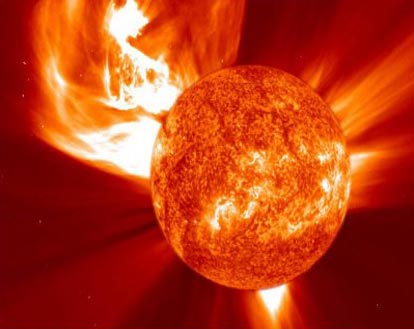NASA has announced it is developing an early warning system for solar flares to give the Earth more time to prepare for storms, thus reducing damage. Scientists from both NASA’s Goddard Space Flight Center and Imperial College London published their research and experiments in Space Weather in the June 9 edition. Their research demonstrates how the new warning system can both measure and model coronal mass ejections (CMEs) and how this can help predict how CMEs will affect the Earth.
“Coronal mass ejections are huge bubbles of superheated gas. The bubbles erupt near the surface of the sun, spreading outward, sometimes as far as Earth. Whether the wave of electromagnetic energy and particles would affect Earth depends on the location of the CME, the direction it spreads, the orientation of the magnetic field, and the size and severity of the burst,” according to Jilard News.
“Although scientists currently monitor the sun for such events, they measure the initial eruption but do not have a good model for how the magnetic cloud travels toward Earth. This makes it difficult to determine whether the burst would affect the Earth, and by what degree. Right now, using satellites, scientists can only detect the orientation of the magnetic field when it is only half an hour to an hour from hitting the Earth’s atmosphere. This does not give much time for power grids and those using GPS or satellite communications to prepare for a possible disruption. In the current study, the researchers are improving the ability of those on Earth to predict the cloud’s behavior, giving them more than a day to prepare for the coming event,” Jilard News reports.
The new detection system would use cameras on satellites in multiple locations to estimate where the approaching solar storm is located and in what direction it is traveling.
“This data is then combined with coronographs from the sun itself, provided by the ESA/NASA Solar and Heliospheric Observatory (SOHO), which show how the CME moves towards Earth,” according to the news report.
When CMEs and magnetic clouds reach Earth’s atmosphere, they affect the earth’s magnetic field, thus resulting in solar storms. Solar storms greatly disrupt electronic systems including satellites, navigation systems, GPS systems, communication systems, aircraft, power grids, radios, televisions and more. This new warning system will give people an extra day to prepare for a solar storm or blast. One day of preparation will greatly minimize damage to electronic systems, since many systems can be shut off before the electromagnetic energy hits Earth.
The scientists have already successfully tested a model of the system on eight mass ejections and NASA plans to continue testing. The research group’s next step is to create an interface that makes the warning system easy to use. NASA hopes the system will be able to assist in monitoring space weather in the future.
